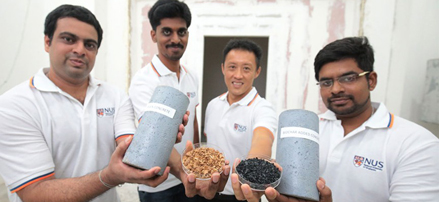
The research team led by Associate Professor Kua Harn Wei (first person from the right)
Wood waste from furniture factories makes up a huge portion of waste generated in Singapore. In 2016 alone, more than 530,000 tonnes of wood waste were produced, of which, a significant amount is in the form of saw dust. Source: Timberbiz
Instead of incinerating or disposing them in landfills, wood waste can be recycled to make biochar, a porous, carbon-rich material that absorbs and retains water well.
Due to its good water absorption and retention properties, biochar is largely employed in the agricultural industry as soil amendment to improve crop yield.
Associate Professor Kua Harn Wei, his PhD student, Mr Souradeep Gupta, and their team from the Department of Building at the National University of Singapore (NUS) School of Design and Environment further expanded the application of biochar by successfully using biochar recycled from saw dust to significantly improve the mechanical and permeability properties of concrete and mortar.
The improvement in the performance of concrete and mortar is achieved by adding a small amount of dry biochar powder into the concrete or mortar mixture. The added biochar alters the conditions in the mixture and enhances the curing and hardening of the mixture.
In the experiments, the researchers found that improvement in early strength and impermeability of the concrete and mortar mixture can reach up to 20% and 50% respectively.
This can facilitate early removal of formwork, which substantially saves construction time and cost. Furthermore, biochar itself ‘locks in’ carbon in its structure, which would otherwise be released to the atmosphere by decay or by incineration of biomass. The use of the biochar technology in concrete construction is therefore a novel and innovative way to store carbon in buildings while promoting recycling of wood waste and strengthening building structures.
“This is a simple and affordable strategy to enhance our building structures, particularly in Singapore, where water leakage from rain and water pipes are common problems,” Assoc Prof Kua, said.
“At the same time, we are putting the large amount of wood waste generated in Singapore into good use. Close to 50 kilograms of wood waste can be utilised for every tonne of concrete fabricated. We typically require 0.5 cubic metre of concrete for every square metre of floor area built in Singapore. This translates to around six tonnes of wood waste being recycled to build a typical 4-room HDB unit with a floor area of 100 square metres.”
The NUS team is currently in discussion with a local firm to explore the commercialisation of this technology, and is also leveraging this technology to develop other high performance cement composites with a wide range of applications.





